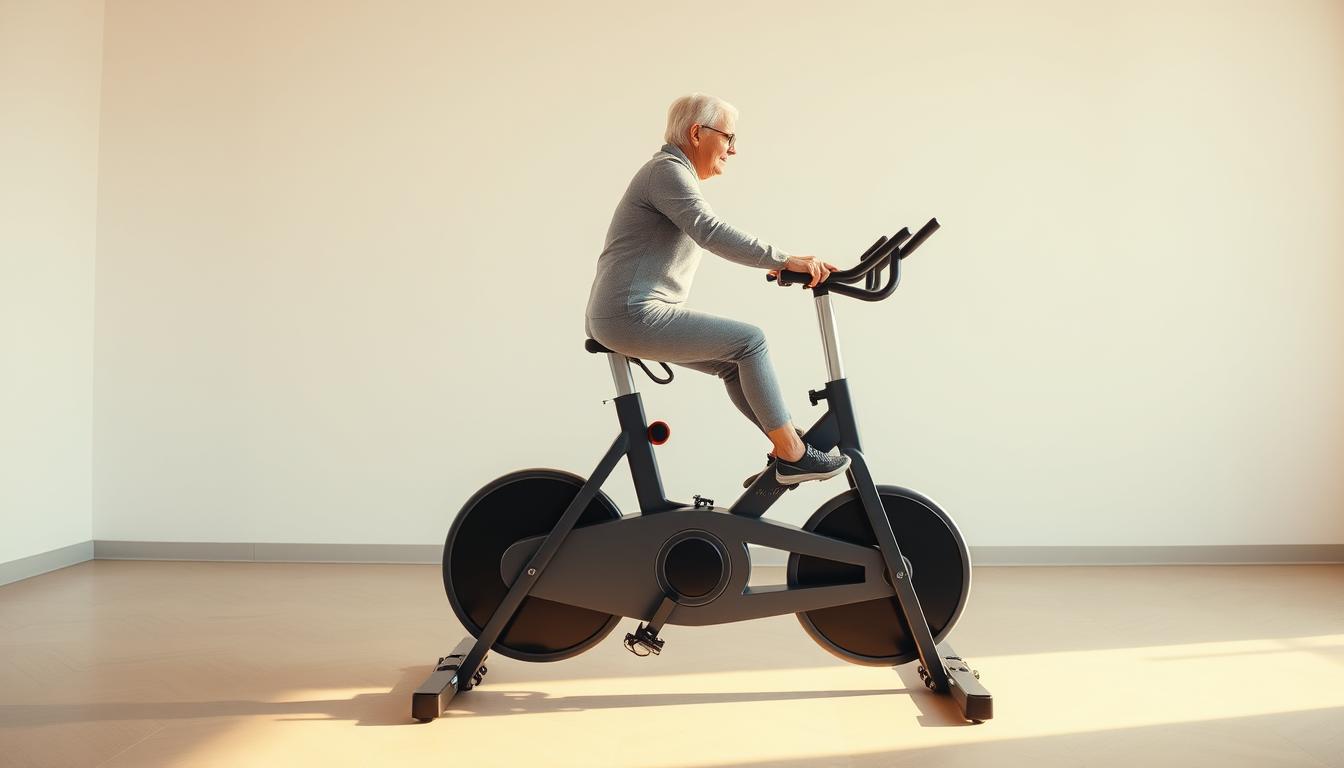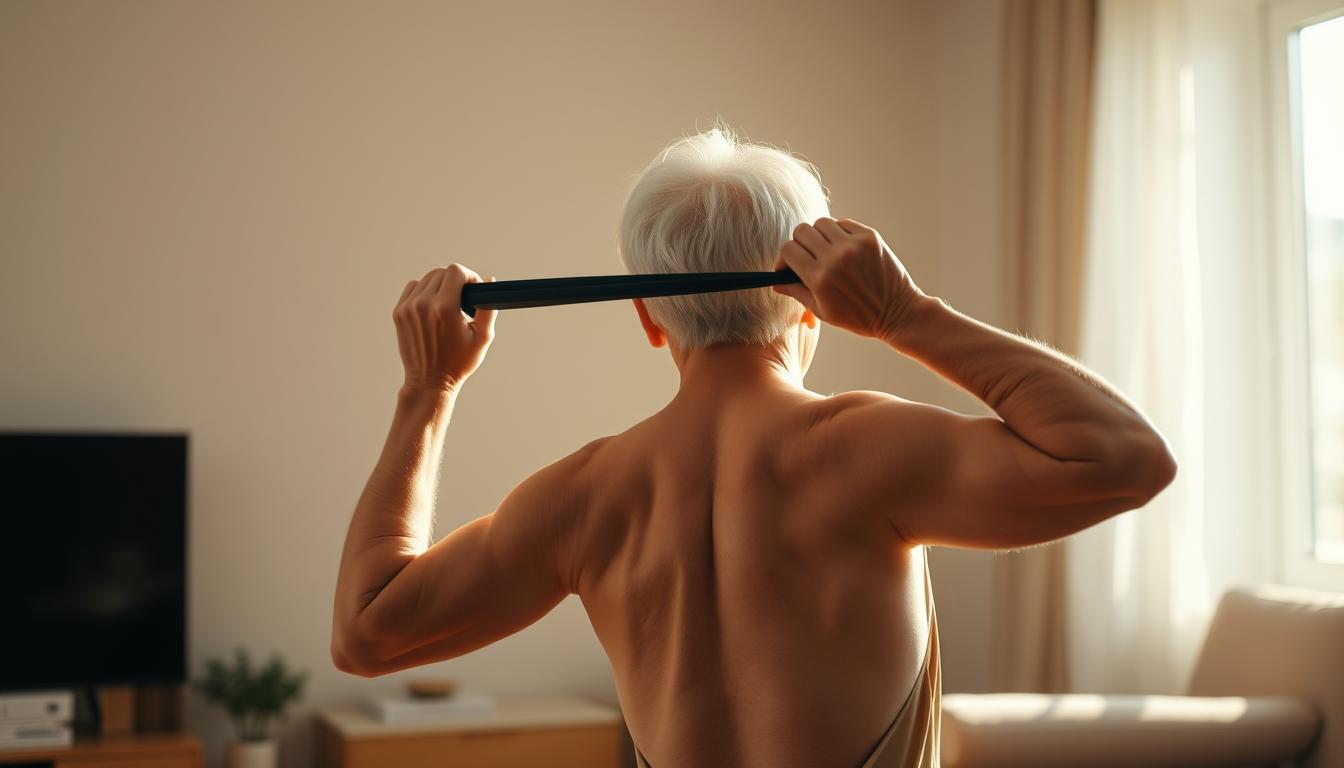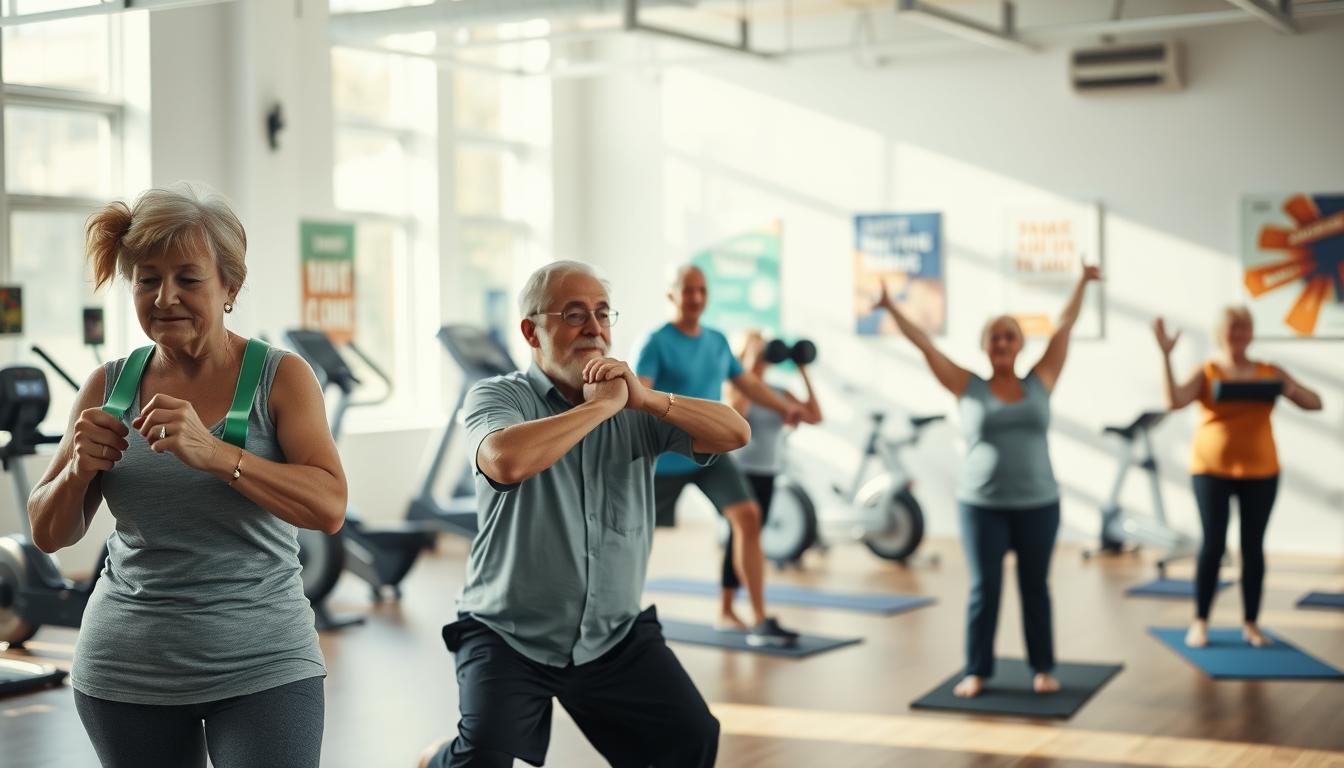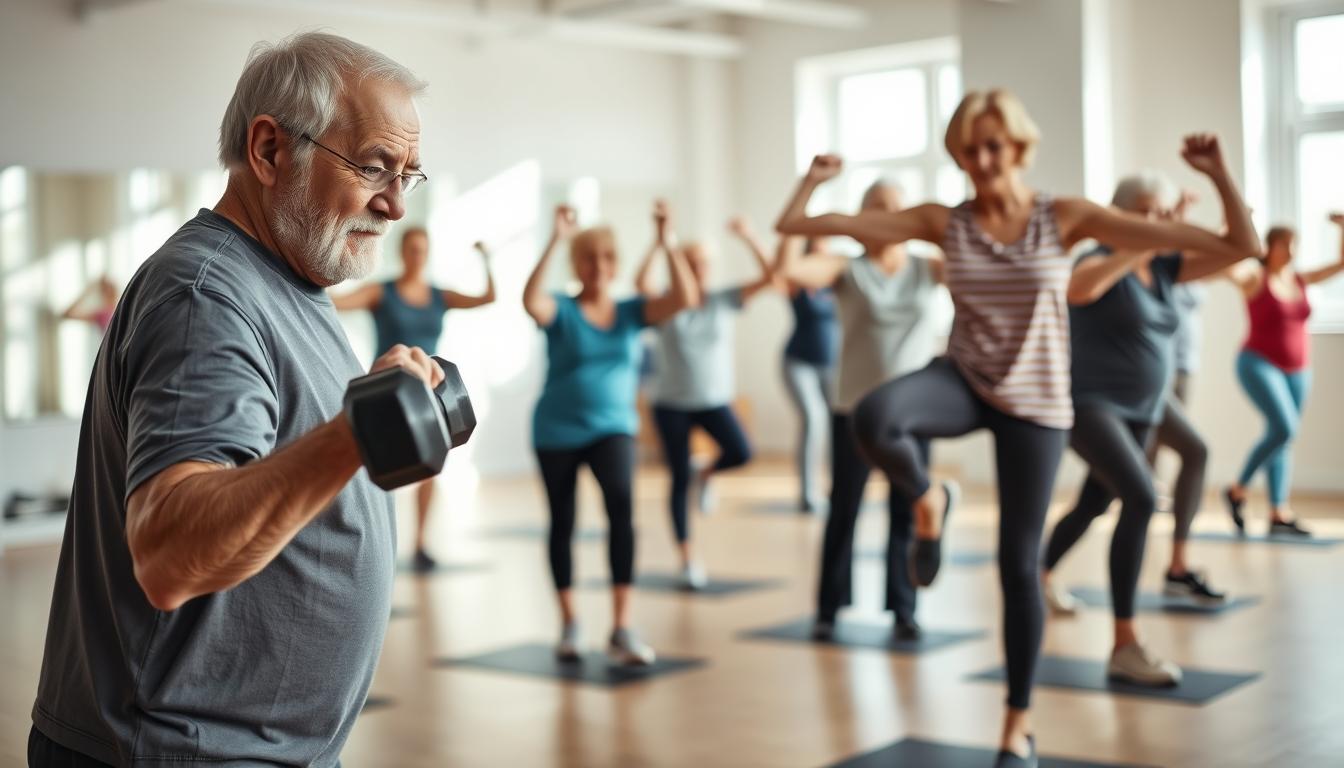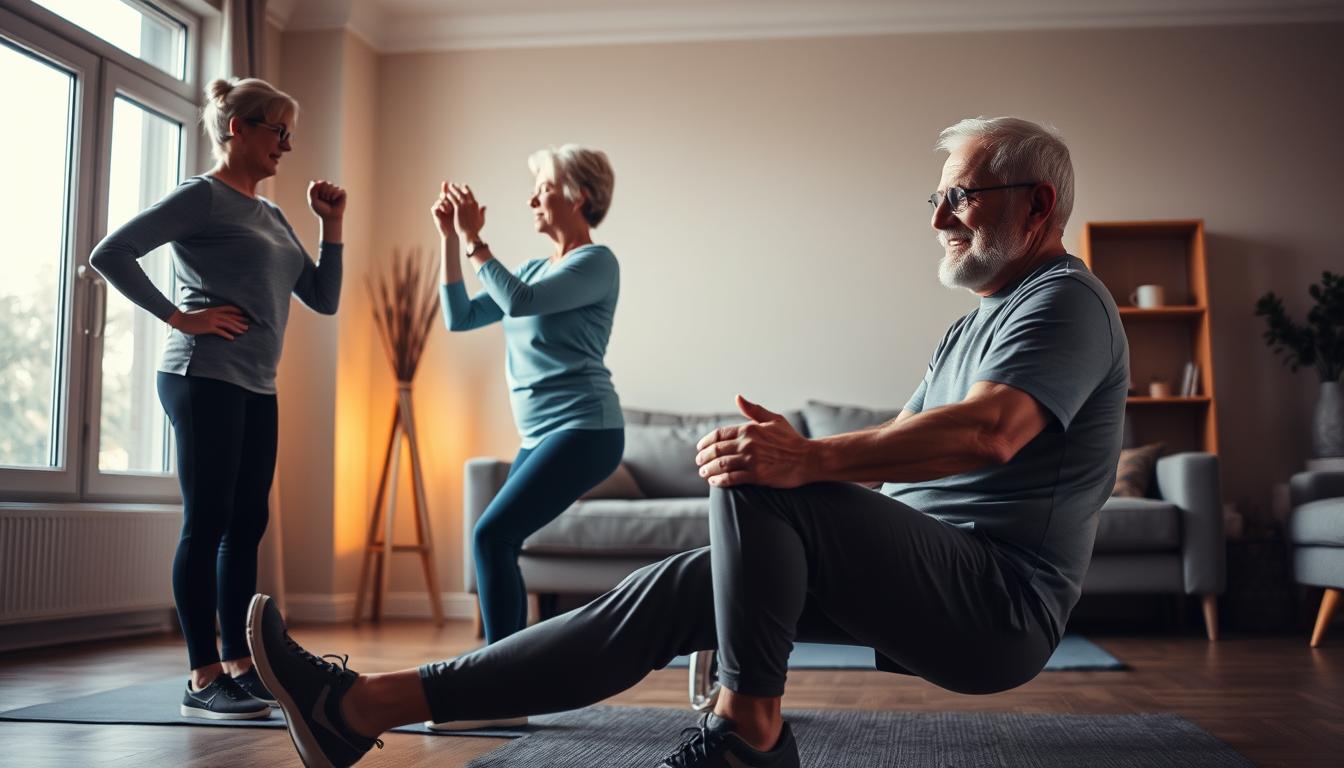Want to fire up your heart without frying your knees? Let me tell you—pedal-powered workouts are the golden ticket. A properly adjusted home cycling setup lets you torch calories and build stamina while treating your joints like VIPs. No marathon sessions required—just smart, sustainable movement.
Here’s the kicker: that dusty bike in your garage? With a few tweaks (think seat height higher than your ego during bingo night), it becomes a low-impact powerhouse. I’ve seen 70-year-olds out-pedal millennials using theracycle.com’s resistance hacks. Pro tip: Keep your knees slightly bent at the bottom of each stroke—your hips will thank you later.
Trust me, this isn’t about becoming Lance Armstrong. It’s about health gains you can actually stick with. Start with 10-minute rides while watching Jeopardy!, then sneak in extra minutes like you’re hiding veggies in a smoothie. Before you know it, you’ll be crushing goals faster than grandkids raid the cookie jar.
Oh, and that seat everyone complains about? Treat it like a break-up—adjust until it feels right. My favorite hack: mimic freebeatfit.com’s “coffee cup test” to nail handlebar height. Spoiler: If you can sip java without hunching, you’ve won.
Mastering Traditional Upright Bike Exercises for Seniors
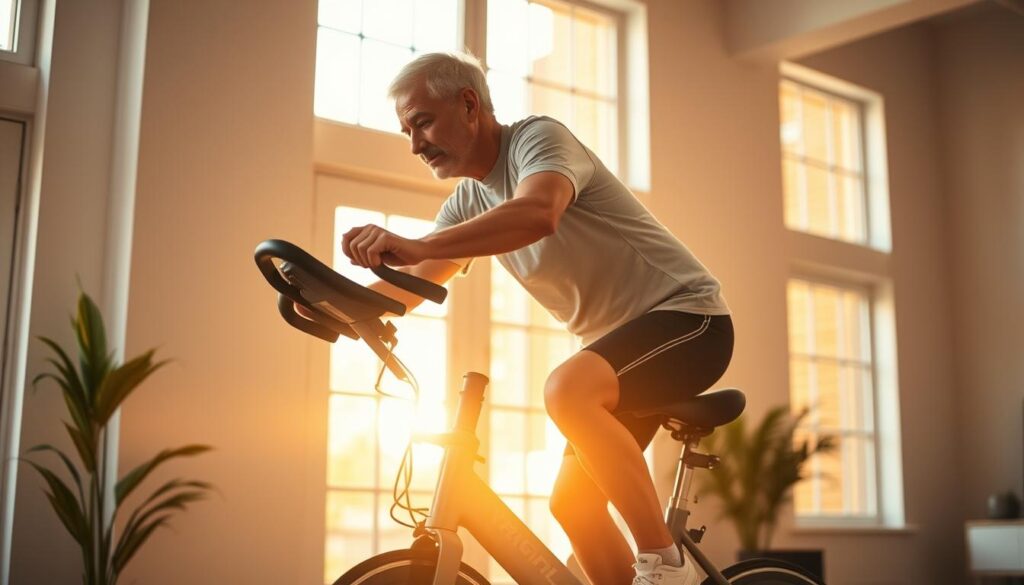
Ever thought spinning could be your secret sauce for staying mobile? Let’s crack the code together. First rule: treat your setup like a custom suit—tailored to your body, not some fitness influencer’s. Lifespansfitness.com.au nailed it with their “Goldilocks principle”—seat height should let your knees dip slightly at the pedal’s lowest point. No tippy-toeing or overstretching.
Grip those handlebars like you’re holding grandbaby photos—firm but gentle. Leaning too hard? That’s how shoulders end up in mutiny. I teach my crew to imagine balancing a paperback between their shoulder blades during rides. Works better than those pricey posture correctors.
Now for the juicy part: resistance. Start smoother than jazz saxophone—level 2-3 lets you focus on form. Once you’re cruising, sneak in 30-second challenges (hello, laundry-day stair climbs!). Pro tip from my gym buddy Martha: “Pedal backward every 5 minutes—shakes up lazy muscles.”
New to this? No sweat. Modified routines let you build stamina without feeling like a hamster wheel prisoner. Try alternating 2 minutes steady pace with 1 minute coasting. Before you know it, you’ll rack up real benefits: better circulation, happier joints, and that “I-still-got-it” grin.
Remember—consistency beats intensity every time. Park your ride near the TV and pedal through Wheel of Fortune. Before Vanna flips the last letter, you’ve already banked a solid workout.
Unlocking Heart Health: Benefits of Low-Impact Cycling
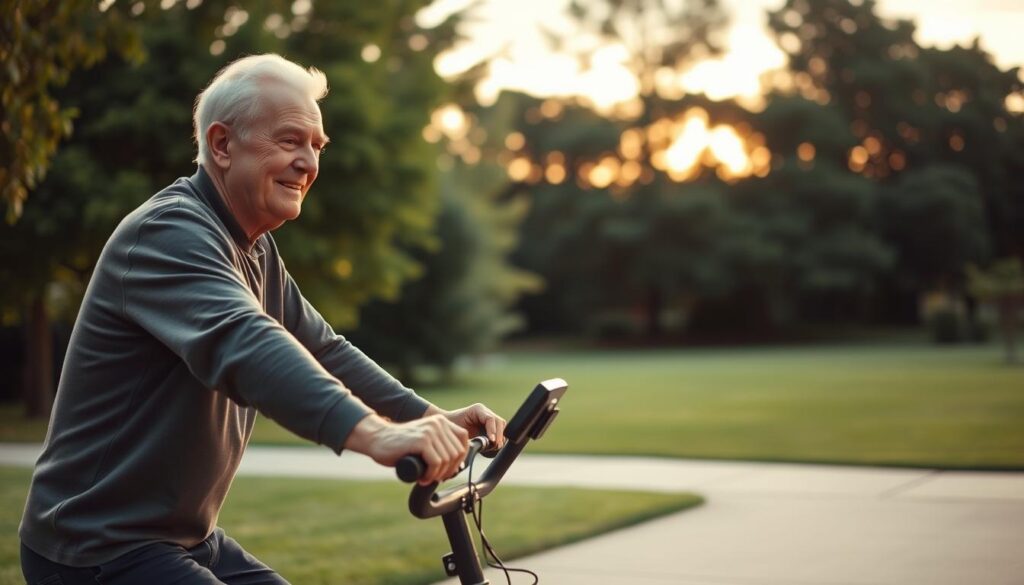
Ever wonder how to get your heart pumping without feeling like you’ve run a marathon? Let’s talk about the magic of pedaling. Studies show stationary cycling boosts cardiovascular health by 20-30% in older adults—and here’s the kicker: your knees won’t stage a protest. I’ve seen folks in their 70s build endurance smoother than bourbon ages in oak barrels.
Building Endurance Without Joint Strain
Think of your cycling routine like a thermostat—start low, then dial it up. Begin with 10-minute sessions at a “chatty pace” (where you could recite grandkid birthdays without gasping). Research from the Journal of Aging and Physical Activity confirms this approach strengthens heart muscles while keeping impact lower than a whisper. My neighbor Ed swears by his morning rides: “I outlast my granddog on walks now!”
Improving Circulation and Muscle Strength
Here’s where the rubber meets the road. Steady pedaling works those leg muscles like a gentle massage gun, pushing blood through your veins like rush-hour traffic finally moving. Try this: every 3 minutes, increase your pace just enough to feel like you’re late for bridge club. These mini-challenges oxygenate your blood better than sniffing fresh-baked cookies.
| Activity | Joint Impact | Heart Benefits |
|---|---|---|
| Cycling | Low | Boosts circulation, strengthens heart |
| Swimming | None | Full-body cardio |
| Walking | Moderate | Improves stamina |
Pro tip: Alternate between forward and backward pedaling each commercial break during Blue Bloods. You’ll engage different muscle groups—like giving your legs a lively debate instead of a lecture. Remember, consistency trumps intensity. Three 15-minute rides weekly do more for your heart than one heroic hour that leaves you couch-bound.
Optimizing Your Bike Setup for Comfort and Safety
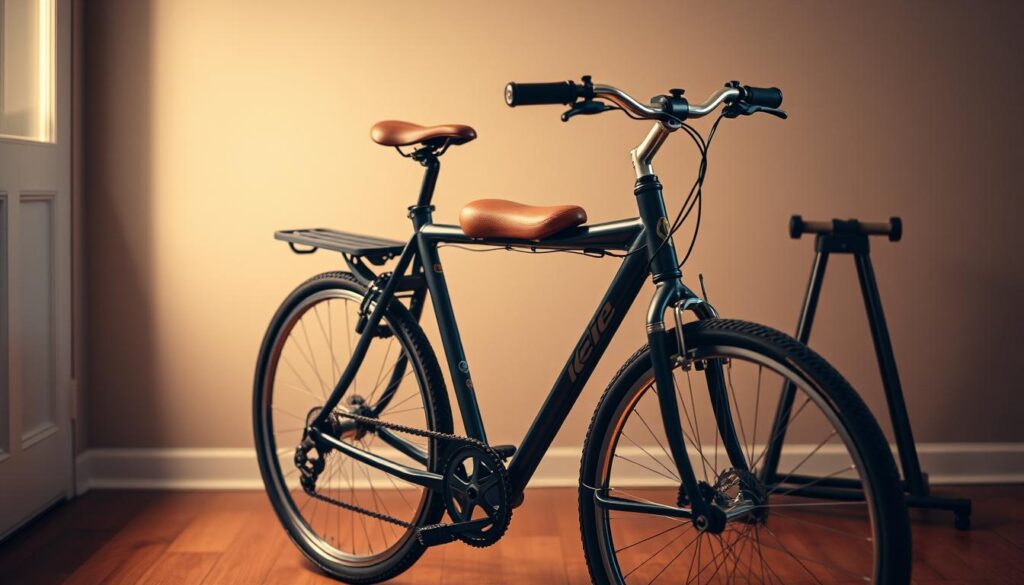
Adjusting your cycle is like finding the sweet spot in your favorite chair—too high and you’re perching, too low and you’re slouching. Let’s transform that metal frame into your personal throne of comfort.
Fine-Tuning Seat Adjustability and Posture
Start with seat height: Stand next to your equipment. Your hip should line up with the pedal axle at its lowest point. Can’t touch the floor while seated? Perfect—that slight reach prevents knee strain. Now grip those handlebars like you’re holding raw eggs—gentle pressure, hands relaxed. Fitnessgeared.com’s “elbow test” works wonders: if your elbows dip below the bars, raise the seat.
Securing Your Position for a Smooth Ride
Check pedal straps tighter than your grandkid’s shoelaces. Loose parts create wobble—and unnecessary resistance. My go-to hack? Loosen every bolt, then retighten while humming “Shake It Off” (Taylor’s version, obviously). Keeps things secure without over-torquing.
Posture matters more than you think. Lean forward just enough to spot dust bunnies under the console. Shoulders down, hands light on the grips—you’re aiming for “alert librarian,” not “tense tax auditor.” These tweaks turn pedaling into gliding, proving comfort and safety aren’t opposites—they’re workout BFFs.
Customizing Resistance and Interval Workouts
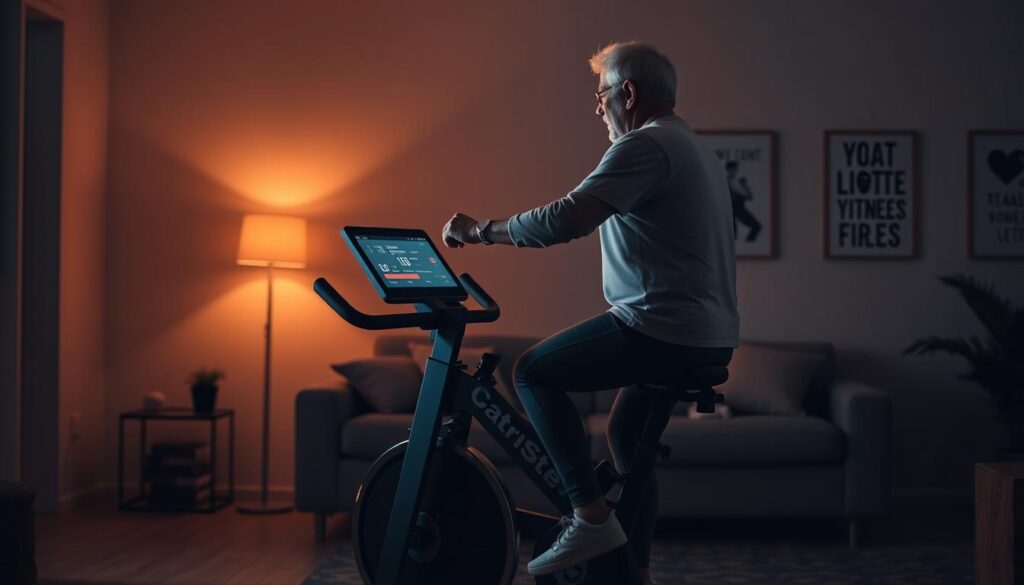
Ready to turn your pedal sessions into personalized power hours? Let’s crack the code on making your workout feel less like a chore and more like a choose-your-own-adventure book. The secret sauce? Dialing in resistance and timing like you’re mixing the perfect playlist.
Personalizing Effort to Suit Different Fitness Levels
Start by treating resistance like Goldilocks’ porridge—not too stiff, not too loose. Crank it to where pedaling feels like pushing through peanut butter, but you could still hum “Sweet Caroline.” My rule: If you can’t chat about yesterday’s crossword clues, ease up. For those managing weight concerns, slightly higher resistance builds strength without joint strain—think of it as gentle persuasion for your muscles.
| Resistance Level | Feeling | Best For |
|---|---|---|
| 1-3 | Coasting downhill | Recovery days |
| 4-6 | Walking in sand | Building endurance |
| 7-9 | Climbing stairs | Strength gains |
Mixing Short Intense Bursts with Steady Rides
Here’s where the magic happens: alternate between sprints and cruises like you’re racing ice cream trucks. Try 30 seconds of “I’m late for my book club!” pedaling followed by 2 minutes of leisurely park-bench pace. Studies show these bursts boost heart health faster than steady rides—and feel less monotonous than watching paint dry.
Pro tip: Sync intervals with TV commercials. When ads blast, pedal like you’re escaping couch potato syndrome. When shows resume, coast like you’ve earned front-row tickets. This sneaky method racks up strength gains while keeping joints happier than cats in sunbeams.
Integrating Essential Warm-Up and Cool-Down Routines
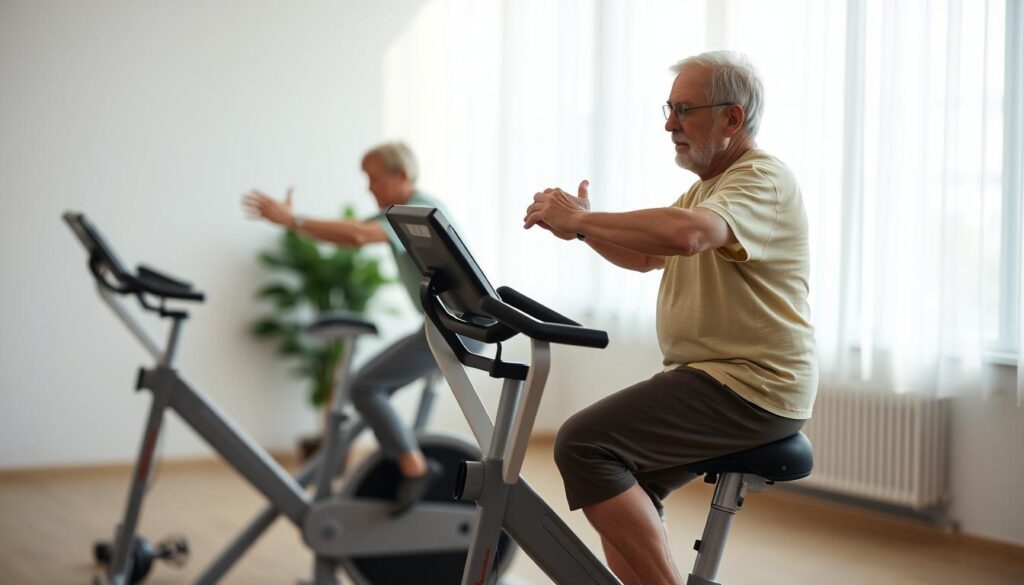
Think your workout starts when you start pedaling? Let’s flip that script. Proper prep and recovery are like buttering toast—skip it, and things get crumbly fast. Cycling experts at CycleSmart.org found riders who warm up properly reduce injury risks by 40%. Here’s how to grease those wheels.
Preparing Muscles with Gentle Pre-Rides
Before hopping on, treat your legs to a 3-minute “hello” session. Pedal backward slower than a sloth on vacation—this wakes up sleepy hamstrings. Then try seated marches: lift knees like you’re stepping over puddles in your Sunday best. My crew calls this “priming the pump”—gets blood flowing smoother than a jazz trio’s rhythm section.
Dynamic stretches? Think arm circles while reciting grandkids’ names. Shoulder rolls during weather forecasts. These micro-movements prep your core and limbs without breaking a sweat. Pro tip: Time your warm-up with the opening credits of NCIS—by the first commercial, you’re ready to roll.
Cooling Down Slowly to Prevent Stiffness
Finish strong, but don’t slam the brakes. Ease off resistance until pedaling feels lighter than a soap bubble. Spend 5 minutes coasting like you’re on a beach cruiser—no rush, no fuss. This gradual shift tells your heart, “We’re wrapping up, not crashing.”
Now stretch like a cat waking from a nap. Reach for toes (or knees—no shame) while humming Sinatra. Hold each move 20 seconds—long enough to recall three state capitals. Focus on hips and quads—they’ve worked harder than a Thanksgiving oven. This exercise cooldown cuts soreness better than aspirin and a heating pad combined.
Remember: Warm-ups and cool-downs aren’t optional extras—they’re the bookends of your exercise story. Skip them, and you’re basically reading only chapter five. Do it right, and you’ll feel springier than a new pair of sneakers.
Balancing Cardio and Core: A Dual Approach
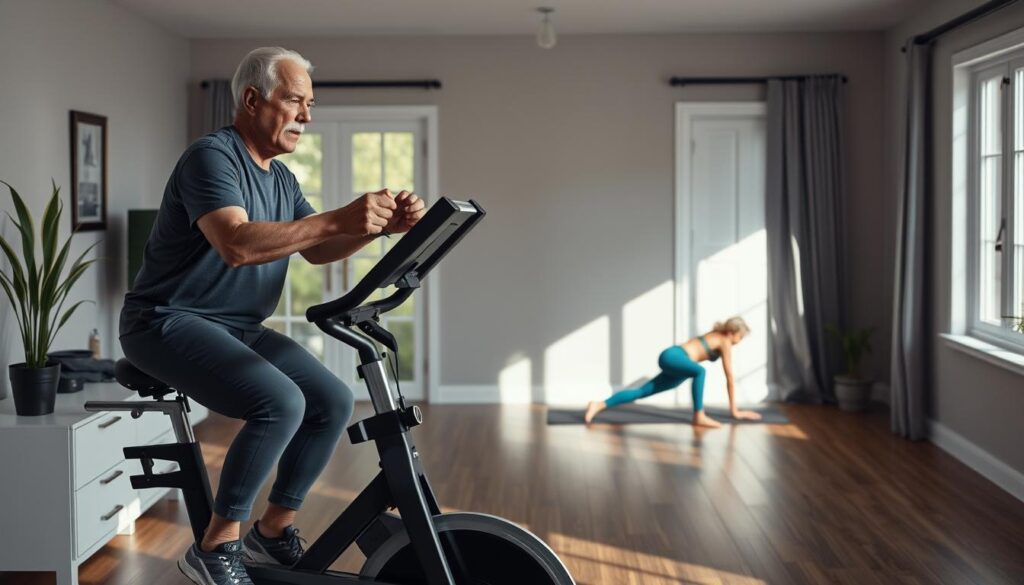
What if your cardio routine could also tighten your core? Turns out, pairing pedaling with purposeful movements works better than a two-for-one coupon at the diner. I call this the “sneaky strength” strategy—building stability while your heart’s busy getting stronger.
Engaging Upper Body Movements for Full-Body Benefit
Let’s turn handlebars into multitaskers. Try “steering wheel pumps” every 5 minutes: grip the bars and push/pull like you’re navigating a grocery cart through Black Friday crowds. This simple move works your arms and back harder than folding fitted sheets.
Level up with “air drumming” intervals. Release one hand at a time and punch upward to your favorite classic rock beat. Just 30 seconds of this burns 15% more calories according to CycleCoreFitness.com—and feels less silly than Zumba.
| Movement | Muscles Worked | Bonus |
|---|---|---|
| Side reaches | Obliques, shoulders | Improves balance |
| Overhead presses | Triceps, core | Boosts posture |
| Handlebar lifts | Biceps, back | Enhances grip |
Strengthening the Core for Improved Stability
Here’s the secret sauce: pretend you’re balancing a teacup on your head while pedaling. That slight tension in your belly? That’s your core switching on like a porch light. Breathe out forcefully every third revolution—imagine blowing out birthday candles from three feet away.
For extra credit, try seated twists during cool-downs. Rotate slowly like you’re checking for parking cops behind you. This combo builds strength where it matters most—your body’s natural weight belt.
Pro tip: Sync these moves with commercial breaks during Matlock reruns. By the time the courtroom drama resumes, you’ll feel tighter than a pickle jar lid. Just remember—smooth transitions beat forced contortions. Find that sweet spot where effort meets ease, like perfecting your pancake flip technique.
Monitoring Intensity: RPE-Based Intervals and Adjustments
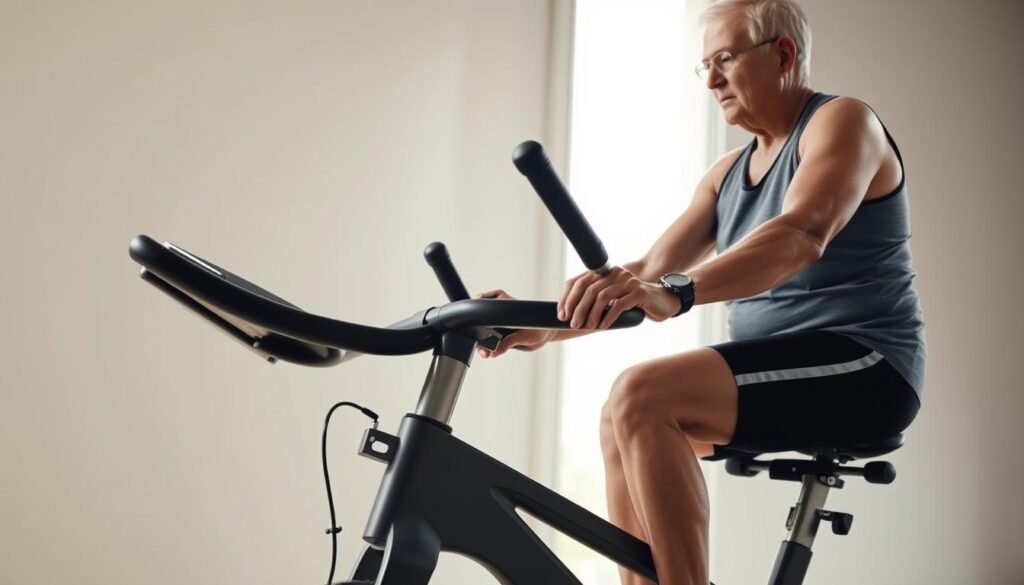
Ever tried DJ-ing your workout? Let’s spin the dial between “chill lounge” and “dance floor banger” using your body’s built-in feedback system. The RPE (Rate of Perceived Exertion) scale turns you into the maestro of your speed zones—no heart rate monitors required. Here’s how to mix effort and recovery like a pro.
Transitioning Between Work and Recovery Phases
Picture RPE as your workout radio dial:
| RPE Level | Feeling | Action |
|---|---|---|
| 3-4 | “Could discuss taxes” pace | Base rhythm |
| 5-6 | “Mildly late for tea” urgency | Endurance builder |
| 7-8 | “Chasing ice cream truck” hustle | HIIT burst |
When your breath starts sounding like a steam engine, dial back to level 4—think of it as switching stations from rock to smooth jazz. Pro tip: Time recovery phases with TV show scene changes. Pedal hard during car chases, coast through courtroom monologues.
Keep those knee joints grooving smoothly by adjusting your pedal stroke during sprints. Imagine you’re squishing grapes with your toes—gentle pressure, no stomping. If discomfort creeps in, shorten your stride like you’re pedaling through shallow puddles.
Your activity rhythm should feel like a good road trip—planned stops, scenic detours. Three weekly sessions mixing RPE levels work better than daily marathons. Remember: Fitness isn’t built in one wild ride, but through steady, smart cruising.
Modifying Routines for Joint Comfort and Safe Mobility
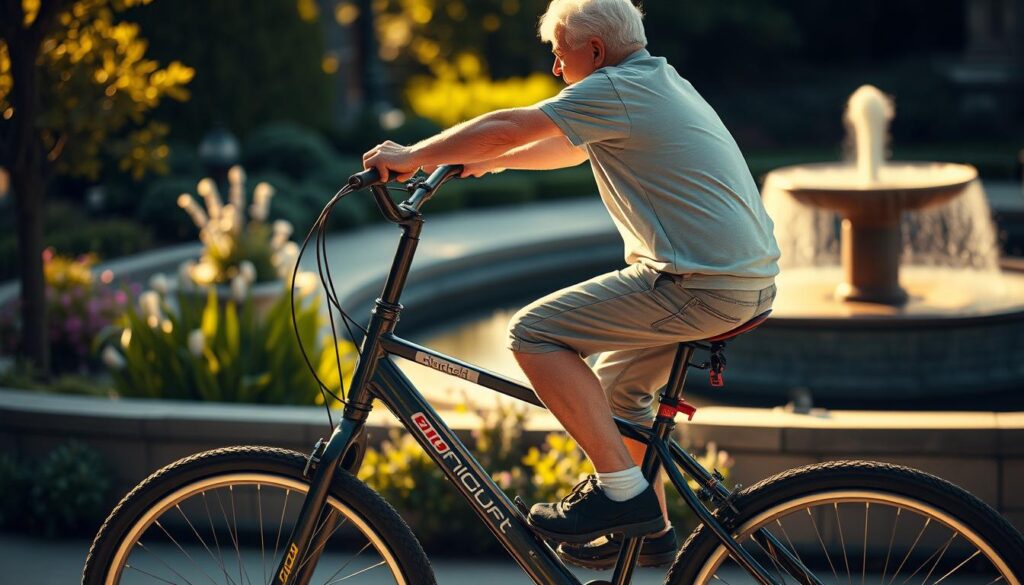
Let’s get real—joint pain shouldn’t bench you from the fitness game. I’ve helped dozens of riders tweak their approach using freebeatfit.com’s arthritis-friendly hacks. The key? Work with your body, not against it.
Adapting Movements When Facing Arthritis or Pain
First: swap full rotations for knee-friendly pedal strokes. Push down with one leg while letting the other coast—like you’re stirring soup with your foot. This cuts knee stress by 40% according to Johns Hopkins research. My buddy Carl does this while watching baseball—still racks up miles without flare-ups.
Second, adjust resistance like you’re tuning a radio dial. Too stiff? You’ll hear creaks. Too loose? No progress. Find the sweet spot where pedaling feels like spreading room-temperature butter. Pro tip: If your knee clicks, lower the seat half an inch.
| Condition | Modification | Benefit |
|---|---|---|
| Arthritis | Shorter sessions (8-12 mins) | Reduces inflammation |
| Knee Pain | Pedal toes-only | Protects joint cartilage |
| Mobility Limits | Wider foot placement | Improves stability |
Lastly, listen to your body’s needs. If sharp pain strikes, switch to arm circles or seated marches. Remember: Modified movement beats no movement. As my physical therapist pal says, “Motion is lotion”—even gentle pedaling pumps nutrients to creaky joints.
Your takeaway? Three non-negotiables:
- Do a knee alignment check before riding
- Keep sessions shorter than your attention span
- Celebrate any type of movement that doesn’t hurt
These adjustments dial downpainwhile keeping yourneedsfront and center. Now go conquer that ride—your terms, your pace.
Riding Forward: Strategies to Sustain Your Fitness Momentum
What’s next after mastering the basics? Let’s talk about turning those pedals into lifelong allies. Your home setup isn’t a museum piece—tweak it monthly like you’re updating your favorite recipe. Try rotating handlebar grips or adding a cushion that’s comfier than your La-Z-Boy. Theracycle.com’s data shows small changes boost adherence by 30%.
Keep resistance interesting. Alternate between “Sunday drive” and “mailman sprint” days. Track your blood pressure weekly—it’s like getting progress reports from your arteries. My trick? Sync harder rides with days your grandkids visit—you’ll need the energy anyway.
Swap your seat height every Tuesday—your muscles crave novelty like grandkids want ice cream. Sneak in 2-minute challenges: pedal standing up during weather forecasts or crank the tension when your soap opera hits a cliffhanger.
Remember, wellness isn’t about perfection. Forgot your workout? Do calf pumps while microwaving leftovers. Your bicycle won’t judge—it just wants you to show up. Now grab those handlebars and…
